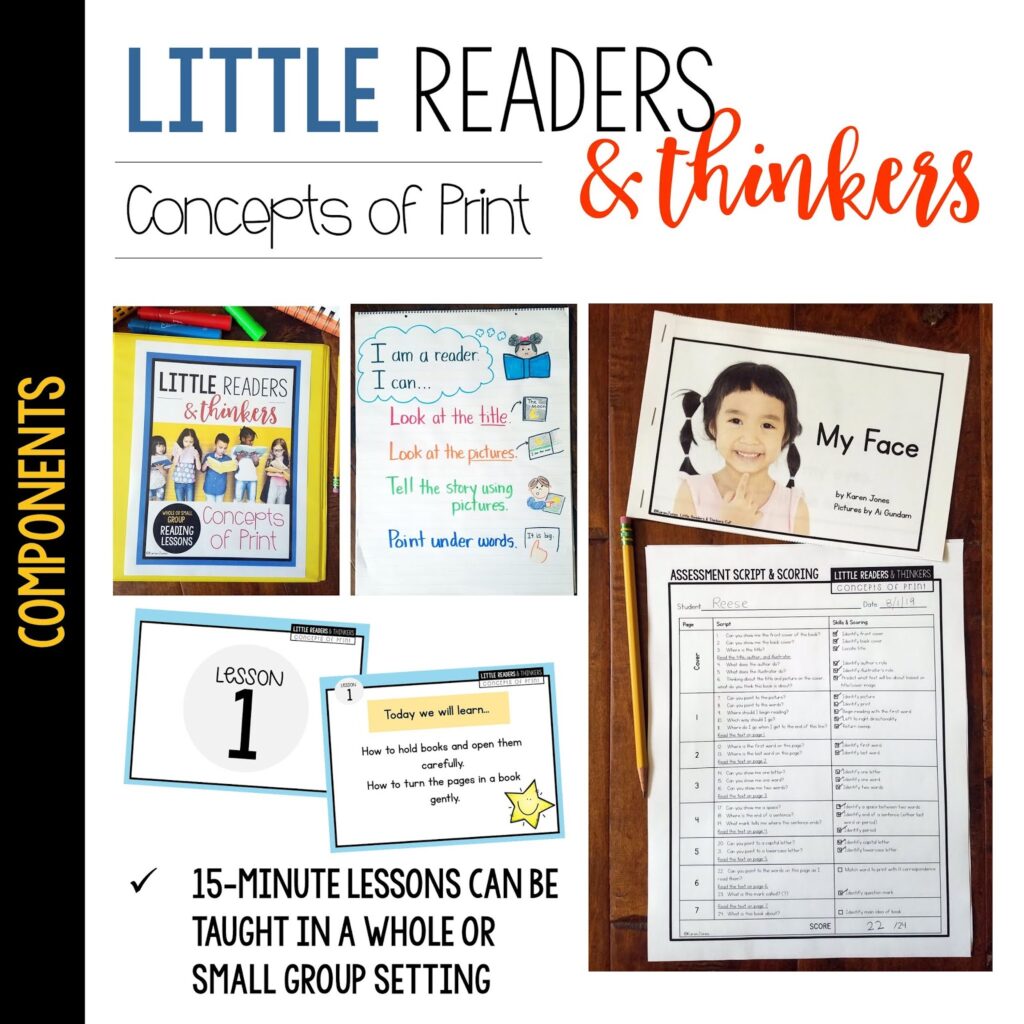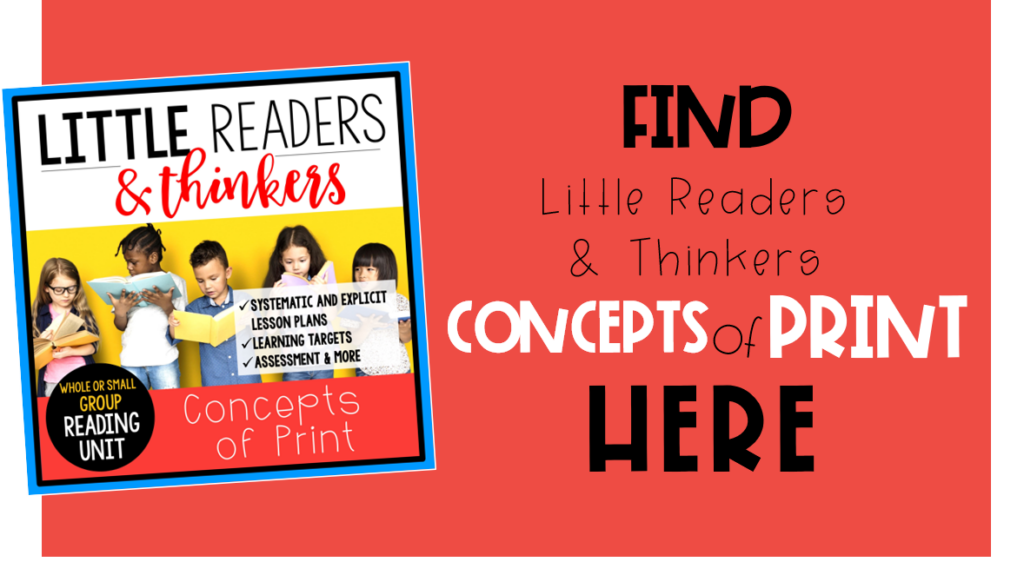Concepts of print refers to the understanding of how print and books work. These skills are a critical prerequisite to teaching children to read.
Concepts of print include:
-How books are read
- Concepts of print are instinctive to proficient readers — they “just know.” In fact, it’s hard to remember not knowing these things! Many children acquire concepts of print through being read to regularly by a caregiver. For some children, though, these concepts must be directly taught.
- Concepts of Print Choose a Level C-F book for the administration of this assessment. It should have distinct layout of print and illustrations, good spacing of words and multiple lines of text. Begin by telling the child, “I‟m going to read you this story and I want you to help me. It is called.” 1.
- . Concepts of print refers to the understanding of what print represents and how it works as well as the knowledge of elements of books and how they work (Concepts of Print PPT). Concepts of print include knowledge that: § Print represents language (in a written form) § There are various functions of print (it is used for a variety of purposes).
Created using PowToon Created for ED 305. Concepts of print are a great predictor in a child’s future success as a reader. Concepts of print influence a child’s fluency and accuracy as a reader later in life. Instructors will assume that all children know the concepts of print when the student enters the classroom, but that is not always true.
-Identification of parts of print
-Print orientation
-Parts of a book
Kindergarten reading instruction sometimes begins with the assumption that students have an understanding of most concepts of print. Unfortunately, students who come to school without these skills can fall behind right away if the direct instruction and modeling of these important skills is overlooked.
A strong foundation in early literacy skills including direct instruction in Concepts of Print can ensure reading success in later years. (C.Johnson, 2015). Early onset of Concepts of Print skills correlated to a stronger reading ability in later years. Tizard (1988) stated that CoP awareness at the age of 4 was a strong predictor of reading achievement at ages 7 and 11.
The main Concepts of Print skills include the concepts of a book and understandings of print. I will go in depth with each of those concepts below.
Concepts of a book refers to the understandings of how books work. Children should understand where the front cover, back cover, and title page are in a book. They should know how to handle books properly, hold books with correct orientation, and turn the pages sequentially. They should understand the job of the author and illustrator. They should follow pages in a book from left to right. They should understand that words are read from top to bottom on a page.
Understandings of print refers to just that– understanding how print works. Children should understand that the print in a book conveys the story or message. They should understand the differences between words, letters, and punctuation. Words are separated by spaces. They should understand that sentences are a complete thought. That they begin with a capital letter and end with punctuation. They should be able to identify the first letter and last letter of a word, and the first and last word in a sentence. They should be able to point to words with 1:1 correspondence.
We as teachers cannot ignore the importance of direct instruction in Concepts of Print as the early onset of reading instruction in our classrooms. But, how? What exactly do I need to teach my students? How do I make sure that I’m providing them with instruction on all concept of print skills? Where do I begin teaching my students how to read?
Little Readers & Thinkers: Concepts of Print provides you with 14 days of strategic and explicit instruction in all Concepts of Print skills. It provides you a framework of knowledge of what your students need to learn, the progression of skills that makes sense for kindergartners, and the specific teacher language that can be used to teach.
The lessons in this unit follow a traditional Reading Workshop format: mini-lesson, practice, and share. The lessons can be taught in either a whole group or small group format.
Concepts Of Print Anchor Chart

Teachers, let me help.
Join my email list and receive a free Guided Reading Teacher Toolkit.

Developing concepts of print is an important part of the emergent literacy process. The best thing about teaching concepts of print to young children is that you don’t need any extra tools or supplies, you just need books!
What Are Concepts of Print?
The basic understandings of how books and print work are referred to as concepts of print.

These print concepts include:
- Letters and words hold meaning
- Print is what we read
- Illustrations correspond to the print
- We read from left to right
- We read from top to bottom
- Return sweep – when we get to the end of a line on a page we return to the next line and begin reading on the left again
- Books have a front, back, and an author
- Difference between a letter and a word
- Spaces between words
- Where to start reading
- One-to-One Correspondence – Print matches spoken words
- Punctuation
Why Are Print Concepts Important?
Before children can begin to read, they must understand how books and print work. Considered precursors to reading and writing, concepts of print are crucial for future reading success.
How Do Children Develop Concepts of Print?
Young children may begin to develop concepts of print at a very young age. How quickly young children learn concepts of print is directly related to how often they are read to.
The best way to teach young children about concepts of print is to invite them to explore books, writing, and drawing as often as possible.
10 Ways to Develop Concepts of Print
1. Point to the words in books as you read-aloud to develop one-to-one correspondence between spoken and written words.
2. Point out words, spaces, letters, lines of print, left to right, top to bottom, direction of print during your morning message.
3. Use environmental print to make references to words, spaces, letters and lines of print.
4. Have children suggest where the teacher should begin reading the words on the page of a big book.
5. Count the words in a line of print or clap for each word spoken aloud can help develop concept of a word.
How to Teach Concepts of Print
6. Use student name cards and classroom labels to help children recognize words that are most meaningful to them.
7. Use a variety of hands-on activities to develop an awareness of letters, e.g., play with letter cars, magnetic letters, plastic letters and alphabet games.
8. Display an alphabet chart at children’s eye level and refer to it daily.
9. Provide both upper and lowercase magnetic letters of the alphabet for children to use daily.
10. Invite each child to dictate a sentence. Write each child’s sentence on a sentence strip twice. Cut one sentence into individual words and encourage children to match words to the second sentence strip, specifically using “first word,” “last word.”
Concepts Of Print Lesson Plans
The Teaching Tribe
Concepts Of Print For Kindergarten
Teaching concepts of print is important, but it’s only one small piece of the literacy puzzle. If you really want to bring your A game, the best place to learn current best teaching practices and get the support you need is in the Teaching Tribe. We have many printable lessons and on-demand video trainings to help you become the best teacher you can be! If you want to get on the waiting list for the Teaching Tribe, do it soon so you don’t miss the next open enrollment period!
Concepts Of Print - Image Results
More Literacy Ideas
